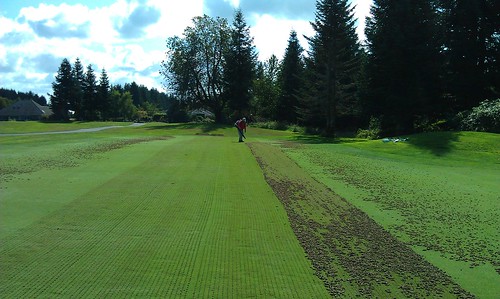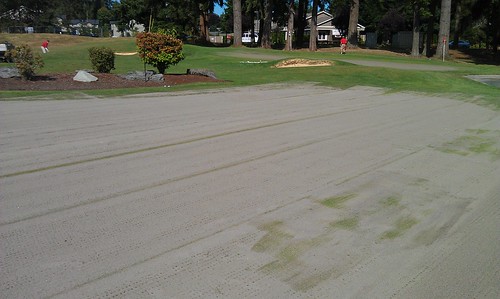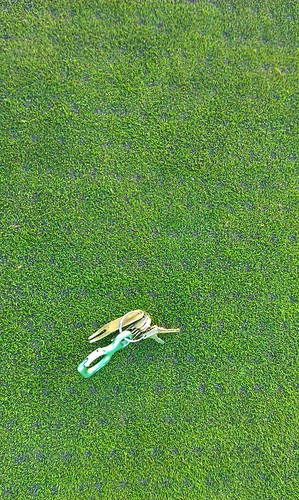Ok, I will explain the process from the beginning. You can skip ahead if you already know the basics.
First off a degree day is a unit you can calculate using a base temperature and a maximum threshold temperature. Some insects or weeds (poa) can have different min and max temps for calculation.
Example would be Masked Chafers have a lower max temp than billbugs. This temperature is important only when the high for the day is greater than the threshold.
These parameters are the limits of that insect or plant’s active development. That is what we are trying to measure so we can anticipate optimum stages to control with either cultural or chemical practices.
Once you have the starting date to begin GDD measurement of the specific insect or plant which is usually March 1st, but can also be January 1st, then you are ready to get started.
The basic way to measure degree days can be calculated as follows:
Take the daily low and the daily high and add them together. Then divide them by 2 to get the average for the day. Take the average and subtract your base temperature. If the number calculated is positive then you have accumulated degree day units. If the number is negative then zero is accumulated. You take this measurement daily starting at your scheduled date March 1 or Jan 1. Each days accumulation is added together to get the overall collected GDD’s.
The number from this calculation is a decent way to figure out your degree days but it is not as accurate as the sine wave method. The sign wave method takes in account the time during the day that the temperature is within the optimum development temperature. This calculation is done with a complicated formula programmed into a computer. The website that I have used, with this option accesses a weather station very close if not on your property.
http://www.uspest.org/.

You can make use of the maps and zoom into your property and find a nearby weather station. An ideal situation would be on your property but over a few years of data collection you can get really accurate keeping track of when insects emerge or locating them at the ideal stage of development for control.
I used the internet to look up the insects that we deal with annually. I looked for growing degree day models for each insect and found a lot of info that was useful.
For billbugs we use growing degree days to anticipate spring emergence for contact control and egg hatch for larvae control. We also match this data with pitfall traps and adult count to see if we are on track. Usually you can get pretty close at recognizing a peak in capture numbers and degree day accumulation. That is when we use a contact product to reduce the population heading to mate and lay eggs. I am hoping we can get to a point where this is all that is required and we can accept minor damage from the survivors. We continue to accumulate GDD’s to anticipate the most vulnerable stage at which we can get control with a systemic. I also forecast this number to allow time for the chemical to enter the plant and move through the plant using phloem and xylem, if that is how the chemical works in the plant.
Cutworms are a little different. We use light traps to observe peak flight. Once we have collected a peak in capture numbers then we begin our degree day count to anticipate the proper instar stage to get the greatest efficacy from our chemicals or my goal is to begin using nematodes. Once you get the hang of anticipating these insects with great accuracy then we can think about using biological control that may only be in the soil for days or weeks rather than getting a synthetic chemical with long residual.
Above, I mentioned trapping. I use pitfall traps for billbugs and a light trap for Masked Chafers and Cutworms.
Pitfall traps are placed a couple paces from the native areas, parallel to the maintained turf edge, and located in severely damaged areas in the previous years or a south facing slope because it will warm up the quickest in the spring. I also slightly angle the pipe downhill so there is a slight elevation change to drain water and make it an easy trip for the billbugs to follow to the collection can. I use an eight foot section of 2” pvc with a slit cut down the middle about a ¾ of an inch wide. The action threshold is a judgment made by you. If you collect 5 or 50 it is up to you to determine what is too many.

I have also collected cutworms in these traps. We were surprised to find them.
We have also set up a light trap. I had a horrible time last year trying to keep it running through the summer with the battery dying at night. This year I have a better plan and will have more consistent results. I ordered this trap from
http://www.bioquip.com/. You have your choice between a 12volt or 110volt ballast. I was told that if you can locate it in the middle of your course and in a fairly open area so they don’t have to go through a lot of tree cover to get there. For this reason I went with a 12volt system but I am now thinking about finding a fairly central clock and using the 110volt plug at the bottom for more consistent use.
The trap works well at collecting a ton of insects so I placed a pest strip at the bottom to kill the insects once trapped so they don’t beat themselves up beyond recognition. I use the wings to look for obvious cutworm characteristics. The few days I could get a full night of operation, the trap worked very well. I had to ultimately result to old school curative applications. My goal is to get to where I can apply a contact surrounding the greens and never see them on the green. As we know cutworms lay there eggs on the leaves of the plant. We mow greens daily making it very difficult for survival on the greens surface but the surrounds are a different story and if you spread your green clippings you are also spreading the eggs. Once they hatch they make there way to the green. I have noticed as well that they also favor areas with nearby lighting.

As for Masked Chafer’s the same rule applies. Once peak flight is observed degree day count is collected and then chemical control can be predicted. Again, common sense is used to understand that south facing slopes are usually the worst. Mapping is also very helpful, if you are getting some damage in areas you did not spray. They have some prediction models that you can use to anticipate peak flight but if you have the light trap it seems more accurate and then you can make your own model specific to your course.
The moral of the story is degree day models are just that, a model. They are mostly accurate because growing degree days are calculated according to climate. So, across the country a billbug in Ohio and one here in Arizona may develop at different calendar dates but same degree day counts. It gets you away from the adopted method of following a date, set 30 years ago by some guy spraying mercury based chemistry, to spray April 1st every year. What if you warm up early or get a cold snap. You could potential miss the entire control window or just get horrible results.
If you have any question, please feel free to contact me,
Justin Ruiz, CGCS













































































